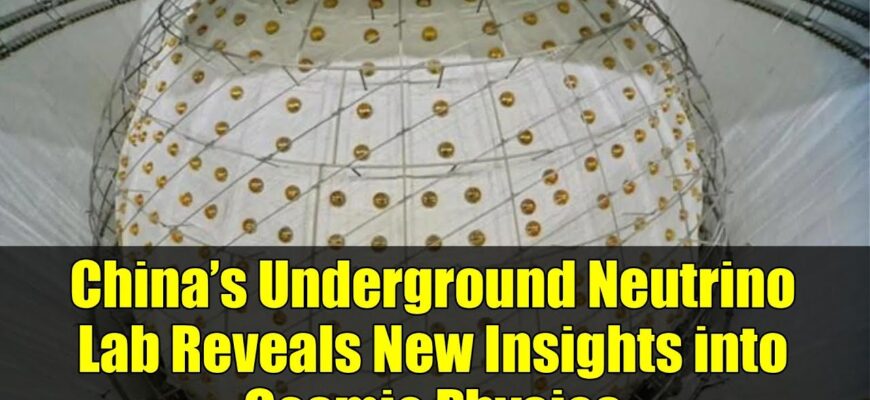The cosmos, a vast expanse teeming with wonders, often guards its deepest secrets with an almost mischievous glee. Among its most elusive inhabitants are neutrinos – ghostly, subatomic particles that zip through us by the trillions every second, rarely leaving a trace. For decades, scientists have pursued these cosmic messengers, hoping they hold the keys to understanding everything from the sun`s fiery heart to the universe`s very origins. Now, China has taken a monumental leap in this pursuit with the launch of the Jiangmen Underground Neutrino Observatory (JUNO), officially the world`s largest and most ambitious facility dedicated to these spectral voyagers.
The Ghostly Messengers: Understanding Neutrinos
Imagine a particle so tiny, so devoid of charge, that it can pass through light-years of lead without so much as a polite nod. That, in essence, is a neutrino. Born from cataclysmic cosmic events like supernova explosions, nuclear reactions in stars (our Sun included), and even the decay of radioactive elements within Earth, neutrinos are often described as the universe`s most introverted particles. They interact so weakly with ordinary matter that detecting them is akin to catching a whisper in a hurricane – an extraordinarily difficult, yet profoundly rewarding, endeavor. Their minuscule mass, hovering tantalizingly close to zero, makes them particularly fascinating to physicists, as it challenges the very foundations of the Standard Model of particle physics.
JUNO: A Colossus Beneath the Earth
To glimpse these shy particles, one must build on a grand scale, and deep underground, far from the distracting chatter of cosmic rays that constantly bombard Earth`s surface. Located 700 meters (approximately 2,300 feet) beneath the tranquil landscape of Jiangmen City in China`s Guangdong province, JUNO is an engineering marvel. After over a decade of meticulous planning and construction, this subterranean giant officially began its data collection phase on August 26th, signaling a new epoch in neutrino research.
At the heart of JUNO lies its crown jewel: a colossal 20,000-ton liquid scintillator detector. This isn`t just a big tank; it`s a precisely engineered acrylic sphere, 35 meters (115 feet) in diameter, filled with a special liquid. When a neutrino, on its rare occasion, decides to interact with an atom in this liquid, it produces a faint flash of light – a scintilla – which is then detected by an array of ultra-sensitive photodetectors lining the sphere. It`s an elaborate, high-stakes game of cosmic hide-and-seek, where the “seeker” is a vast, sophisticated machine.
Unlocking the Universe`s Deepest Riddles
JUNO`s primary mission is as ambitious as its scale. By precisely measuring neutrinos from a myriad of sources, scientists aim to tackle some of the most profound questions in physics and astrophysics:
- Neutrino Mass Hierarchy: One of the most significant puzzles in particle physics is the “mass hierarchy” of neutrinos – which of their three known types is the heaviest and which is the lightest. JUNO`s unprecedented precision is expected to provide a definitive answer, potentially revolutionizing our understanding of fundamental forces.
- Solar and Geo-Neutrinos: The observatory will meticulously study neutrinos streaming from our Sun, offering an unparalleled look into its nuclear fusion processes. It will also detect geo-neutrinos, particles generated from radioactive decays within Earth`s mantle, providing insights into our planet`s internal heat engine.
- Supernova Relic Neutrinos: Should a supernova occur anywhere in our galaxy during JUNO`s operational lifetime, the observatory is perfectly poised to detect the burst of neutrinos it would emit. This would offer a unique window into stellar collapse and nucleosynthesis.
- Reactor Neutrinos: Located just 53 kilometers from the Taishan and Yangjiang nuclear power plants, JUNO will also analyze neutrinos produced by these reactors, providing a controlled environment to refine our understanding of neutrino oscillations – how these particles change types as they travel.
`[The launch of the neutrino observatory] will provide answers to questions about the nature of matter and the Universe.`
— Wang Yifang, JUNO Project Representative
A Global Endeavor, A Future Defined
JUNO is not merely a Chinese triumph; it`s a testament to global scientific collaboration. Over 700 researchers from 74 scientific institutions across 17 countries have contributed to its conception, construction, and operation. This international partnership underscores the universal human drive to explore and understand our cosmos.
With an expected operational lifespan exceeding 30 years, JUNO promises a generation of groundbreaking discoveries. As the liquid scintillator now hums with the silent ballet of neutrino detection, humanity inches closer to deciphering the fundamental fabric of reality. The universe`s ghostly messengers have found their most sophisticated listener yet, and the secrets they hold may soon be revealed.








